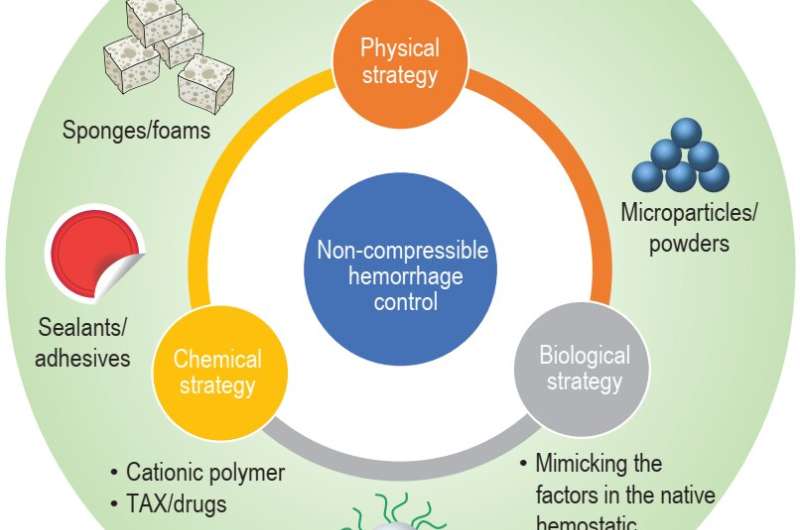Non-compressible hemostatic materials: Design strategies, formulations, and challenges

Non-compressible hemorrhage control is a challenging topic both on the battlefield and in civilian life. Various forms of hemostatic materials have been designed. Different researchers design their materials based on different strategies and focused on solving different kinds of problems that exist in the non-compressible hemorrhage control area.
In this review, Dr. Baolin Guo and his team (Xi'an Jiaotong University, China) systematically summarized the design principles and their related hemorrhage-control strategies, which further affect the differences in hemostatic materials' formulation and functions.
There are several commercialized devices and materials for non-compressible hemorrhage control to date, such as the abdominal aortic and junctional tourniquet (AAJT), resuscitative endovascular balloon occlusion of the aorta (REBOA), iTClamp, RevMedx X-stat, ResQFoam, and Tranexamic acid (TXA).
However, they all showed their own limitations and the demand for easy-to-apply and highly efficient non-compressible hemostatic materials is urgent. Many researchers have attempted to develop new kinds of non-compressible hemorrhage control materials and process them in clinics.
Classified by forms, currently emerging non-compressible hemorrhage control materials can be divided into 4 categories: sponges/foams, adhesives/sealants, powders/particles, and platelet mimics. And the forms of those materials are rooted in the three hemostatic strategies: physical (blocking and physical pressing), chemical (activate intrinsic hemostatic cascades by chemical components), and biological (mimicking the platelets' behavior).
However, currently developed non-compressible hemorrhage control materials still can not fit all requirements of non-compressible bleeding control. "We believe the combination of different hemostatic strategies is a promising solution," Dr. Guo says.
More than effective hemorrhage control, today's requirements for non-compressible hemostatic materials are multi-dimensional. Materials are expected to be removable on demand, beneficial for wound healing, and applicable for bleeding condition monitoring, besides remarkable hemorrhage control effects on non-compressible bleeding. Multi-functional hemostatic materials would be a future direction for the non-compressible hemorrhage control area.
The design and formulation of the materials are important in the development of non-compressible hemorrhage control materials. However, standard and effective methods for the evaluation of hemorrhage control efficiency of materials are also critical. In vitro and in vivo models for hemostatic efficiency assessment are needed to be established.
By giving this comprehensive review, the researchers are willing to inspire more scientists in this area to pay attention to the design strategies and formulations of the hemostatic materials to achieve multi-functional, highly effective, and easily applicable materials for non-compressible hemorrhage control to save more lives in the future.
The research was published in National Science Review.
More information: Ruonan Dong et al, Emerging hemostatic materials for non-compressible hemorrhage control, National Science Review (2022). DOI: 10.1093/nsr/nwac162



















